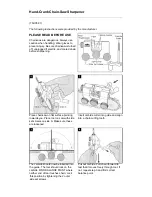
ADJUSTMENTS
16
FENCE ADJUSTMENTS
1. To move the fence across the table, loosen the lock
lever (A), then turn the knob (B) until the fence is in
the desired position on the table and then retighten
the lock lever. FIG. 23.
NOTE:
The handle direction of the lock lever (A) can
be repositioned by pulling up the lever and reposition-
ing it on the nut located underneath the lever.
2. To tilt the fence, loosen the lock lever (A), and tilt
the fence to the desired angle. Then retighten the lock
lever. FIG. 24.
3. The fence has adjustable positive stops at the most
used fence positions of 90 degrees and 135 degrees.
FIG. 24
FIG. 25
FIG. 26
FIG. 23
THE MACHINE MUST NOT BE
PLUGGED IN AND THE POWER SWITCH MUST BE IN
THE OFF POSITION UNTIL ALL ADJUSTMENTS ARE
COMPLETE.
SETTING THE FENCE TO 90° and 135°
To check and adjust the positive stops to the 90 and
135 degree settings:
4. Put a square on the table with one end against the
fence and adjust the fence until it is exactly 90
degrees to the table. FIG. 25.
5. Loosen the locking nut with a 13mm hex wrench
and adjust the Allen screw (A) until a 90 degree
setting is reached. Tighten the locking nut to retain the
adjustment. FIG. 25.
6. To check the 135 degree setting flip the 90 degree
stop tab away from the 90 degree stop bolt. Put a
square on the table with one end against the fence
and adjust the fence until it is exactly 135 degrees to
the table. FIG. 26.
NOTE:
With the fence set at 135°, the jointer will
produce a 45° bevel on your workpiece.
7. Loosen the locking nut with a 13mm hex wrench
and adjust the stop bolt (A) until a 135 degree
setting is reached. Tighten the locking nut to retain the
adjustment. FIG. 26.
A
A
B
A
B
90° Square
90° Stop
A
135° Square
90° Stop













































